Marijampolė
Marijampolė (![]()
Marijampolė | |
|---|---|
City | |
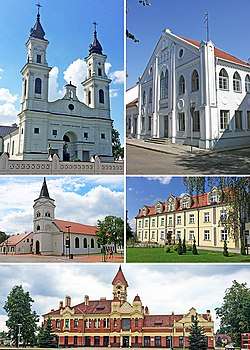 Landmarks of Marijampolė | |
 Flag 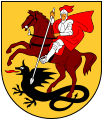 Coat of arms | |
| Nickname(s): Miami of Lithuania (unofficial) | |
 Location of Marijampolė | |
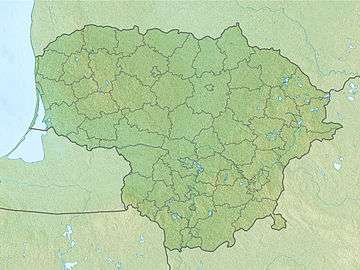 Marijampolė Location of Marijampolė  Marijampolė Marijampolė (Europe) | |
| Coordinates: 54°32′50″N 23°21′00″E | |
| Country | |
| Ethnographic region | Suvalkija |
| County | |
| Municipality | Marijampolė municipality |
| Eldership | Marijampolė eldership |
| Capital of | Marijampolė County Marijampolė municipality Marijampolė eldership |
| First mentioned | 1337 |
| Granted city rights | 1420 |
| Government | |
| • Type | Mayor-Council |
| • Mayor | Povilas Isoda (LSDP) |
| • Mayor deputy | Gintautas Stankevičius (Liberal Movement) |
| • City Council | Councilmembers
|
| Area | |
| • Total | 24.1 km2 (9.3 sq mi) |
| Elevation | 86 m (282 ft) |
| Population (2017) | |
| • Total | 34,975 |
| • Density | 1,500/km2 (3,800/sq mi) |
| Time zone | UTC+2 (EET) |
| • Summer (DST) | UTC+3 (EEST) |
| Postal code | 68001 |
| Area code(s) | (+370) 343 |
| Website | www |
Marijampolė is the seventh-largest city in Lithuania, and has been its regional center since 1994. The city covers an area equal to 205.07 square kilometres (79.18 sq mi). The Šešupė River divides the city into two parts which are connected by six bridges.
Names
The city has also been known as Marijampolis, Mariampol, Starapole, Pašešupiai, Marjampol, Mariyampole, and Kapsukas (1955–1989).
History
The settlement was founded as a village called "Pašešupė", after the nearby river of Šešupė. As such the town was first mentioned in 1667. In the 18th century the village, at that time belonging to the Catholic Church, grew to become a market town and its name was changed to Starpol or "Staropole", after a new village built for Prienai starost's guards in the vicinity in 1739.[1] The settlement was destroyed by a fire in 1765.
After the disaster the wife of contemporary starost of Prienai, Pranciška Butlerienė née Ščiukaitė,[2] financed a new church and a monastery for the Congregation of Marian Fathers.[1] Following the foundation of the monastery, a new town was built in the area. It was named "Maryampol", after the Blessed Virgin Mary (Marya-), with the Greek suffix -pol denoting a town.[3]
On February 23, 1792 King of Poland and Grand Duke of Lithuania Stanisław II Augustus granted the "townlet of Mariampol" with Magdeburg Law and a privilege of market organisation. Following the Partitions of Poland the town was briefly part of Prussia. However, after the Napoleonic Wars it was transferred to Congress Poland ("Russian Poland"). In the 19th century the town continued to grow, mostly thanks to a large number of Jewish and German settlers. In 1817 the town became the seat of a separate powiat within the administrative system of the kingdom.[1] In 1827 the town had 1759 inhabitants. By 1861 the number had grown to 3718, 3015 of them being Jewish.[1] A fire consumed many wooden homes in 1868. As a result, many houses were rebuilt of stone.[4]
Following the January Uprising and the Russian suppression of the former Commonwealth lands, the powiat of Maryampol was seriously diminished.[1] Around that time also the monastery gained prominence as it was the only monastery owned by the Marians that was not closed down by the tsarist authorities.[5] As the surroundings of the town were primarily inhabited by Lithuanians,[1] the town became the centre of the Lithuanian national revival. The proximity of the Prussian border made the smuggling of books in Lithuanian language, banned in Imperial Russia, easier. Among the most notable Lithuanian scholars and writers active in Mariampol at that time were Kazys Grinius, Jonas Jablonskis and Vincas Kudirka.
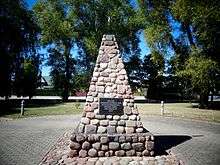
Following World War I the town became part of Lithuania and was renamed to its current name Marijampolė.
During World War II in 1940 Marijampolė was occupied by the Soviet Union. 1940–1941 Soviet authorities deported several hundred inhabitants of Marijampolė. In 1941 Nazi Germany occupied the town. On 1 September 1941, somewhere between 5,000 and 8,000 Jews from Marijampolė, Kalvarija and elsewhere—along with people from other backgrounds—were murdered. Their bodies were placed in mass graves near the Šešupė River. Most of the murderers were Lithuanian.[4][6] In the effect of the war the town was heavily damaged and almost emptied. On July 31, 1944 Soviet army once again entered the city. The following year its counter-intelligence SMERSH repressed about 500 people from Marijampolė. During the first years of Soviet occupation in 1944–1953 Russians deported to Siberian gulags somewhere between 5,000 and 6,000 Lithuanians from Marijampolė county.[7] In late post war years the city was rebuilt and repopulated with inhabitants from other parts of Lithuania. Currently in Marijampolė roughly 98% of its inhabitants are Lithuanians.[8]
On April 9, 1955 communist authorities of the Lithuanian SSR renamed the town to "Kapsukas", after a Lithuanian communist politician Vincas Mickevičius-Kapsukas.[9] The old name was restored in 1989. In 1990 Lithuania regained independence.
Marijampolė is the administrative centre of the county since 1994. In 2018, in the 100th anniversary of the restoration of the independence of Lithuania, the city of Marijampolė became the cultural capital of Lithuania.
The Anshe Sholom B'nai Israel synagogue in Chicago, Illinois, U.S. was founded by immigrants from Marijampolė. Other Jewish migrants from Marijampolė settled in Manchester, England.
Transport
Marijampolė is accessible by railway, Kaunas-Šeštokai-Alytus line. Marijampolė is located at the crossroads of two highways. The Via Baltica connects Helsinki with Central and Southern Europe. The other highway links the city of Kaliningrad with Minsk.
Industry and economy

Marijampolė is connected to its partners by business, sport, education, tourism, and other ties. Marijampolė's local means of mass media include a local television station, a local radio station, the newspapers "Marijampolės laikraštis", "Suvalkietis", "TV savaitė", "Sugrįžimai", and magazine "Suvalkija". Culturally, Marijampolė enjoys one cinema and a municipal drama theater.
Marijampolė is a regional centre of light industry enterprises, construction, transport and trade. It has also become home to one of the largest second-hand car markets in Europe.[10]
Education
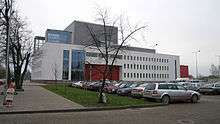
Marijampolė has a strong educational system with state education institutions: 9 pre-school institutions, 6 nursery schools, 1 primary school, 12 lower secondary schools, 9 secondary schools, 4 gymnasium, a youth school, an adult education center, 5 additional training establishments, 3 non-state education institutions, a music school of Christian Culture, gymnasium of Marijonai, and R.Vosylienė languages school.
Marijampolė Municipality
Marijampolė has a City Council with 27 members. The members of the City Council represent different Lithuanian political parties.
The Marijampolė Municipality is adjacent to the Vilkaviškis District Municipality in the west, Kazlų Rūda Municipality in the north, Kalvarija Municipality in the south, and the Prienai District Municipality and Alytus District Municipality in the east.
The town of Marijampolė and its six surrounding communities make up the territory of Marijampolė Municipality. They are: Gudeliai, Igliauka, Liudvinavas, Marijampolė, Sasnava, and Šunskai communities. Marijampolė Municipality covers 755 square kilometres (292 sq mi) of land; 72% of which is an agricultural area, 12.3% is covered by forests; 4.2% – towns and villages, 2% – industrial enterprises and roads, and 6.9% – area used for other purposes.
Twin towns — sister cities
Marijampolė is twinned with:[12]














Notable people
- Violeta Urmana, opera singer, an honorary citizen of the city
- Moshe Rosenthalis (1922–2008), Lithuanian-Israeli painter
- Witold Teofil Staniszkis, Polish politician
- AGE, rock and blues band
- Elada Eimaitė, motivational speaker & writer
- Darius Songaila, basketball player
- Sharune, actress
- Saulius Brusokas, male weightlifter and strongman competitor
Gallery
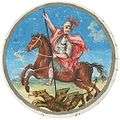 Coat of Arms of Marijampolė city in 1792
Coat of Arms of Marijampolė city in 1792- Battle of Marijampolė (1831)
 Monument for Vytautas the Great
Monument for Vytautas the Great.jpg) St. Michael's Small Basilica
St. Michael's Small Basilica- Church of Saint Vincent de Paul
- Marijampolė Synagogue
- Marijampolė Evangelical Lutheran Church
- Marijampolė Railway Station
- Marijampolė park of "Poetry"
 City days 2013
City days 2013 The House of Pilgrims Domus Beati
The House of Pilgrims Domus Beati- Marijampolė Gymnasium stadium
 Monument for Jonas Jablonskis
Monument for Jonas Jablonskis Monument for the millennia of Lithuania
Monument for the millennia of Lithuania
Notes and references
- various authors (1885). Filip Sulimierski; Bronisław Chlebowski; Władysław Walewski (eds.). Słownik geograficzny Królestwa Polskiego i innych krajów słowiańskich (in Polish). VI. Warsaw: Wł. Walewski. p. 146. Retrieved 2008-08-29.
- Cognate with the Greek suffix -polis. The modern Lithuanian name of the town also follows the same etymology. There are at least ten settlements of the same name in modern Poland, Ukraine and Belarus, all sharing a similar etymology.
- Translation of the Marijampolė chapter from Pinkas Hakehillot Lita
- The Jaeger Report
- "Marijampolės kraštotyros muziejus"
- "2011 m. surašymo duomenys". Archived from the original on 2009-06-01. Retrieved 2009-06-01.
- (in Lithuanian)
- "Marijampolė phenomenon: Centre of Europe in Lithuanian border town". UAB "15min", Vilnius. 8 May 2013. Retrieved 9 January 2017.
- "Marijampolės kolegija". marko.lt. Retrieved 9 November 2017.
- "Miestai partneriai". marijampole.lt (in Lithuanian). Marijampolė. Retrieved 2019-08-28.
External links
| Wikimedia Commons has media related to Marijampolė. |
